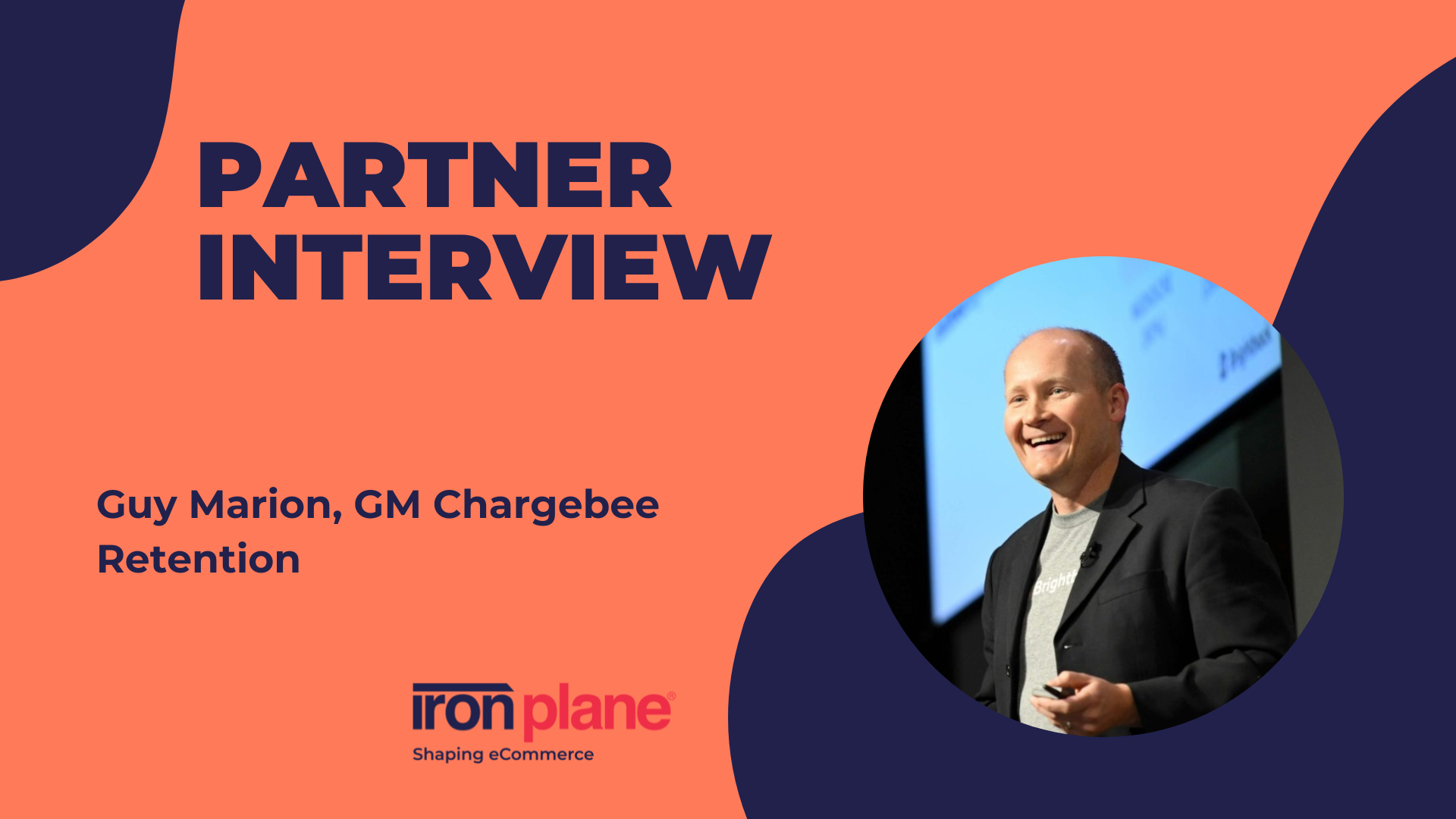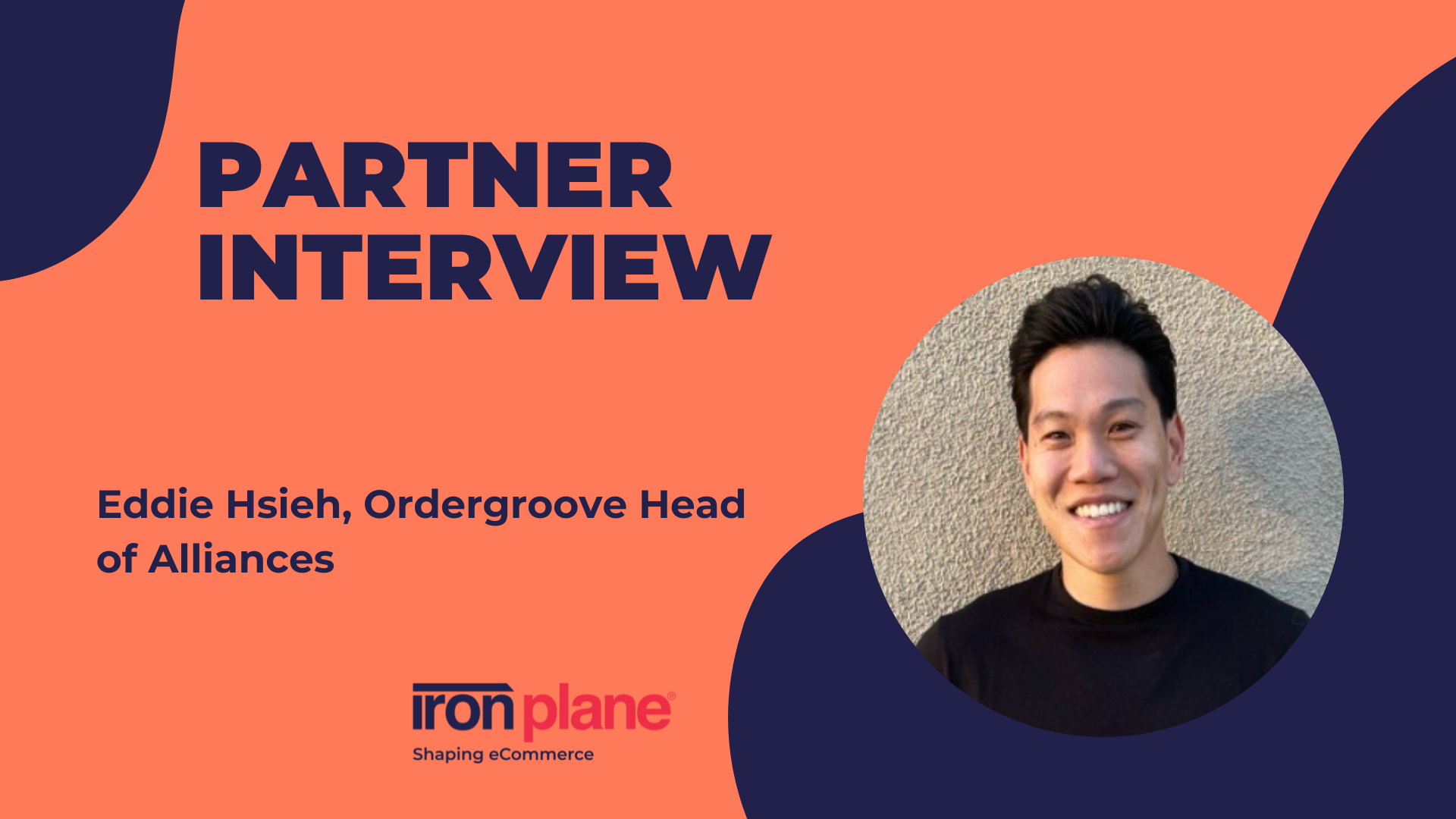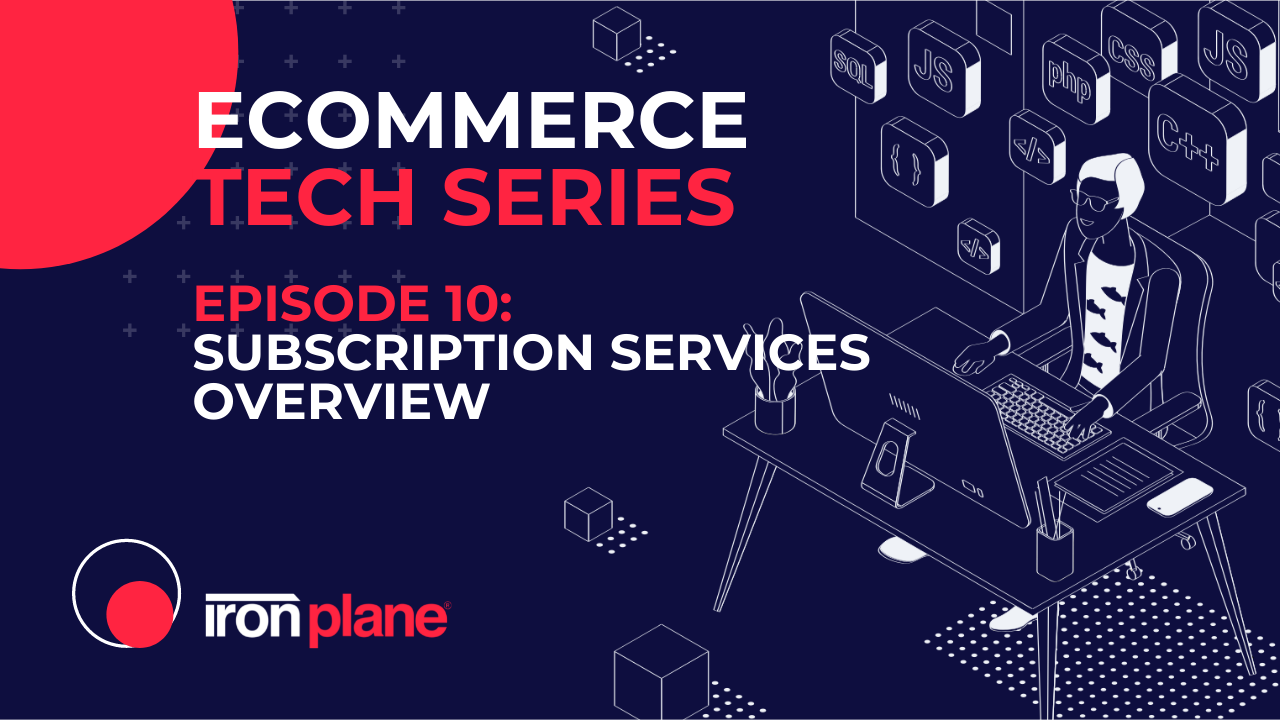Shaping eCommerce with Eddie Hsieh, Ordergroove Head of Alliances
This interview discusses what Ordergroove is, its star customers, and how Ordergroove's AI capabilities improve retention and decrease churn.
15 min read
 Tim Bucciarelli
:
November 8, 2022
Tim Bucciarelli
:
November 8, 2022

Tim Bucciarelli:
Welcome back to another episode of Shaping eCommerce with IronPlane. I’m Tim Bucciarelli, the Director of Engagement for IronPlane, and today we’re continuing our conversation about subscriptions and subscription platforms.
Today I’m pleased to be joined by Guy Marion from Chargebee and Brightback – we’ll get into those two names in just a moment. So, Guy, thank you very much for joining us – if you could give the audience a quick intro to you, your background, and what you do for Chargebee.
Guy Marion:
Yes, thanks Tim. I appreciate you having me IronPlane’s podcast today. My name is Guy Marion. I’m the GM for Chargebee Retention, which is the product line that came out of the acquisition of Brightback, which I founded in 2018.
My background is I’ve been in vendors - in the software and service space serving the eComm space for many years, previously Zendesk, the customer service software, Autopilot, which enables marketers and acquisition teams to eCommerce as well as B2B companies. Then I started Brightback with the objective of helping high-volume subscription services, of which eCommerce is a primary focus, to reduce churn and customer retention and lifetime values that scale automatically with the same type of testing and technologies that are very effective and critical for marketers.
Tim Bucciarelli:
Yeah, and when I first heard about Brightback, it seemed to me like a pretty compelling addition to any subscription program if you’re interested in reducing churn and holding on to your subscribers.
So, we’ll get into that in a little bit more detail. If you just give us a little bit more of a description of the two arms of this business because, as you said, in January they merged – Chargebee and Brightback. What are the functional differences between the two and how does that marriage make for a better product to the end user?
Guy Marion:
So, first of all, a little background on Chargebee. The company was founded in 2011; it’s a global subscription billing leader serving both B2B and eCommerce. We have offices between Channai in India, Amsterdam where the headquarters is, San Francisco, Salt Lake City, and the East Coast of the United States, over 1,000 employees today serving merchants from startups through to enterprise.
And then Brightback, the company that I started in 2018. We were primary U.S. and European-based in terms of customers – mostly fairly high-volume logos and customers that are merchants that are fairly well known.
We, within Chargebee, maintain an independent and focused development roadmap that integrates more and more deeply with Chargebee, but also has integrations with Stripe billing, Recurly, and Recharge, the billing platform popular around Shopify.
Collectively, we have native and deep integration and Chargebee billing customers do receive access now to functionality that’s not available on other platforms, particularly around offer management and revenue recognition, but we will continue to support the eCommerce ecosystem as we evolve and help merchants become more effective at reducing churn and monetizing more easily, and with best practices that wouldn’t be otherwise available.
Tim Bucciarelli:
You mentioned you can service startups through enterprise, and I’m curious. I know we’re dealing with two separate “pools of functionality” here, but I think your audience, your target, is probably similar across the board. If you can give me some idea of what kind of use case you would say is like the target use case for your platform. Because this is a pretty competitive area, who do you think of as your ideal customer profile, let’s say?
Guy Marion:
Typically, the ideal customer profile for a Chargebee customer in the eCommerce space is potentially working with Magento as their eCommerce platform, has either recently established a subscription business or is in the process of doing so, but is already operating at some level of scale, meaning that we typically look at companies that have 250 or more cancels per month, so often they’re in several million in revenue.
On the eComm side, it’s typically several thousand cancels per month and we do think about volumes because of both the subscriptions that those would need to be managed, as well as on the Brightback Chargebee Retention side, we actually identify customers that are likely to cancel and then present alternatives in the forms of offers, personalization, and testing that our customers can easily apply without engineering to reduce churn.
Currently, we reduce 23% of cancellation attempts, which tie into reduced subscriber churn, which is measurable not just in the first month impact but also the subsequent repurchases that those eCommerce customers will provide.
Tim Bucciarelli:
Okay, so we’ve got companies with a fair bit of volume going through their subscription program – that’s great – or, a company – like you said, if it is a startup they view the next three to five years as having rapid growth to get to that volume, and they just want a platform that can grow with them.
What you described on the Brightback side, where you’re kind of preventing these cancels – is that machine learning, essentially, where your system also needs a certain amount of volume in order to get that machine learning to put the proper offer in front of the proper person who’s trying to leave for a particular reason – is that more or less what Brightback is really trying to do?
Guy Marion:
Yeah, that’s more of our future – identifying the right subscribers to save with which offers is actually a challenging problem and one that’s best handled by machine learning at scale. We don’t require the volumes necessary for machine learning to use and get value from the product.
There are actually a lot of controls for early-stage companies to create audiences. For example, customers who are on a certain plan or a certain tenure within their subscriber life cycle – say maybe the first 30 days, or they’re still on a promo / tripwire period for the first 90 days – where our customers can actually build audiences and say, “I want to focus on customers with this plan, this stage, and this level of prior purchases," and create an experience for that user that maybe presents a stronger or a more compelling offer, than customers who are maybe long term, high LTV, or regular users who are perhaps a pause, or a duration change, or an extension, or some additional credit, is sufficient for those loyal customers, which is different than a brand new user who’s still trying to decide if they like the good, or if they’re getting the delivery frequency right, and maybe need to make some fine-tuning.
And what we see is that consumers are very responsive to the right offer at the right time.
Tim Bucciarelli:
Yeah, 23% reduction in churn – that’s pretty attractive, I would say, especially when you’re dealing with thousands of subscription customers.
And what’s interesting to me, coming from the side of Magento – a lot of folks on the Magento platform might be looking to implement a subscription program using a Magento extension, and based on the complexity and the thought that’s going into the Brightback and the Chargebee platforms, it’s worth weighing those options because I haven’t come across an extension that’s as fully-featured and as thoughtfully implemented with all of those configurations that you just described to optimize average order value, subscription, and reduce churn – all in one package.
So, it’s worth it for merchants who are really interested in building out their subscription programs to consider the level of complexity and the value that that complexity and those configurations can bring to their bottom line. It sounds pretty compelling to me, and it’s just an interesting question for merchants to consider, I would say.
Guy Marion:
I think it’s a great point. As we were talking about a few minutes ago, a lot companies and new startups in the eCommerce space or existing traditional retailers who are moving into a digital subscription model will start off with plugins around the Magento ecosystem or elsewhere.
You know, some of the benefits that differentiate Chargebee as a whole – it’s easy to try, easy to implement, we have three plans, we have entry “Launch” plans, we call it, for up to a million dollars of annual recurring revenue.
On the retention and the Brightback side, we also have low cost entry points for companies that are still in the very early stages but need to gather insight into why customers are leaving and provide alternatives that they can learn from, from their customers, and test a pause, or a credit, as opposed to cancelling – even as they’re wrapping.
What I was really excited about, about joining Chargebee, is that we really can provide by being an API first platform that thinks through the user experience and make it easy to try, buy, and use for startups, we really can bring what was traditionally advanced functionality reserved for the enterprise and the big players in town to startups who absolutely need the benefits of quick time to value, build enough functionality that they can start to have different types of products and plans, test those, as well as gather feedback on why their customers are leaving.
Tim Bucciarelli:
Does Chargebee focus on one industry or another? If you can break it out, like one industry might be digital streaming, for example – that’s one type of subscription. Another subscription might be learning again – another type of streaming, I guess. Another subscription might be for coffee or for pet food. Does Chargebee specialize in any particular one of those areas?
Guy Marion:
Yeah, absolutely. Those are great examples. We do absolutely serve and we benchmark, actually, our churn data and our deflection and performance data across a number of core verticals – consumer goods, which would include broadly food, whether it’s baby food, dog food, human food, education is a big space for Chargebee, healthcare, media, entertainment, real estate – these are all spaces that we focus in. Health and wellness has seen a significant increase and rise through the pandemic, obviously, and now coming out of the pandemic. And then apparel and beauty, supplements, and even healthcare are each core verticals that we serve and have specialty offers for cancellation alternatives, for example, and an ability to support the unique plan needs within each of those verticals.
Tim Bucciarelli:
As an end user, I can tell you how much I appreciate that type of flexibility when I can go in and I can adjust all of my settings for whether I want to skip one or whether I don't want to do 30 days, I want to make it 60 days. And if I am away, but I don't want to miss a delivery while I'm on vacation, maybe I can put in a new address for that particular shipment just to temporarily get it there.
Guy Marion:
Yes, and that’s one of the biggest reasons for cancelations. And on a lot of other platforms, you’ll have to do a lot of custom development and hacking around the eCommerce platform. For us, it’s out of the box.
Tim Bucciarelli:
At IronPlane, we work with two eCommerce platforms. We work with Magento, also called Adobe Commerce and we work with BigCommerce. Could you touch on kind of any of the experience that you have with Ordergroove in those particular platforms?
Guy Marion:
Yeah, absolutely. Those are great examples. We do absolutely serve, and we benchmark, actually, our churn data and our deflection and performance data across a number of core verticals – consumer goods, which would include broadly food, whether it’s baby food, dog food, human food, education is a big space for Chargebee, healthcare, media, entertainment, real estate – these are all spaces that we focus in.
Health and wellness have seen a significant increase and rise through the pandemic, obviously, and now coming out of the pandemic. And then apparel and beauty, supplements, and even healthcare are each core verticals that we serve and have specialty offers for cancellation alternatives, for example, and an ability to support the unique plan needs within each of those verticals.
Tim Bucciarelli:
So, let’s just give a quick example like, for me – I have my pet food, and I don’t know if this is one of your clients – if it’s not, I apologize; if it is, you’re lucky – Chewy, for example – I buy my dog food from Chewy, and my cat food, and I have it on a regular schedule, so I am a subscriber to these products.
I go through and frequently have to go back in and adjust my time – the dog ate a lot more than I expected, so I’ve got to get the food sooner, or the cat didn’t eat as much so we get it later, or I need to skip a month because we’re on vacation. That’s the model that we’re talking about here for the subscription element of it.
Then, if I, for whatever reason, decide, “You know what? I’m going to cancel my subscriptions.” At that point, this is where the Brightback tool comes in, and it says to me, “Okay, you’d like to cancel . . . .” Why don’t you explain what that scenario turns into with the Brightback tool?
Guy Marion:
We don’t work with Chewy, but we work with others like Butternut Box is an organic dog food, we have specific cat foods like Smalls and others, and you’re right – it would be, in many cases, customer cancelled not because they dislike that food or even the dog dislikes the food, but it’s too much delivery, or maybe a damaged delivery, or they need to change the frequency and they don’t have easy options to do so.
So, the natural inclination is “I’m just going to cancel my plan and then maybe when I’m ready to restart I’ll come back in four or five or six months. And so alternatively, what the retention platform will offer is, when a user goes to cancel we’ll find out why, so literally survey – sometimes it’s too much food, or dog didn’t like it, or an allergy, or some sort of matter that could be resolved with a personalized account review or pause your plan, or let’s skip a payment or two, or take some credit to try some other ones.
Or, maybe the dog died, which is unfortunately a common reason for churn also, and maybe there, that’s an opportunity for the merchant to really build a relationship with that customer by saying commiserations and actually sending a gift box that would commiserate that and differentiate by establishing that connection with what’s probably going to be a future dog owner again.
Those are the types of opportunities that we open up. In the past, that would be challenging because you’d have to build logic into your products to say, “based on this reason, present this offer,” and map those and wire those up to different changes in the subscription, which is typically beyond the scope of many companies that could do that.
Tim Bucciarelli:
Okay. So, you mentioned one of your clients – any other clients that you think are particularly interesting to talk about?
Guy Marion:
There are companies like Freshly – they’re a US food delivery leader, who was actually acquired by Nestle last year. So if you go to cancel your Freshly plan, you’re going through a Brightback experience. Again, there you can select and provide reasons why you’re canceling and, instead of canceling, taking some extension credit for the next few purchases or pausing or stopping orders for two, four, or eight weeks, are common alternatives to meet the needs of what the customers really have surfaced through internal testing. That has become very, very effective and critical to establishing their LTV to CAC metrics.
Another example in the apparel space may be MeUndies, a well-known brand that provides underwear and garment in both subscription and you can buy one-off, so I can subscribe to boxers, and I can also buy a bra for my wife, for example. And so, in that scenario, being able to both enable the customers to manage the frequency by which they’re receiving underwear – obviously, you don’t want your drawers overflowing – so maybe pause, skip, adjust the number of underwear per package, or be tempted to instead purchase some additional underwear and get that as an alternative to canceling, have also been very effective for that particular apparel company.
Tim Bucciarelli:
I’m just thinking about that – that’s a lot of underwear, potentially! I wonder, is there an element of your churn reduction where you say, “Hey, why don’t you send this as a gift to somebody?” Okay, maybe underwear would be a strange gift, honestly, but is that one of the kinds of options that might be included?
Guy Marion:
Yeah, it’s interesting that you say that. We’ve got a company in the digital space called Babbel, which is one of the largest language learning platforms, and Babbel as a gift is a very, very popular approach for actually acquiring new customers. You’re about to travel to Spain, Tim – I might give you a Spanish language crash course before you go there. So, that actually results in an Amazon gift card being delivered. Execute on that, and that’s an example of where an alternative might be a gift that you can give to a friend of yours, and then you keep your plan, as well.
Tim Bucciarelli:
That’s awesome. That’s great. Okay, if we could talk a little bit about some of the features that you see – and you probably already touched on most of them, but – features that you think differentiate Chargebee and Brightback from the competition. You’ve already mentioned a couple of the competitors in this space. I’m just curious to hear what merchants might be interested in hearing that distinguishes Chargebee from the others.
Guy Marion:
I think there are a few aspects – I think, first and foremost, time-to-value and an easy-to-deploy platform is a key differentiators. Chargebee started as an API for its company, so it’s friendly for developers to work with who are either supporting a code installation, or there’s a portal and a completely self-service approach for engineering-less organizations. So, one differentiator is simply that Chargebee came about in the era of API-first platforms, which means easy to try, buy, and use.
Secondly, the integration with retention – when we started Brightback, we were the only of its kind within the space, so I was the first one to identify this as an opportunity. We’ve tested and have been fortunate enough to work with some industry leaders who were willing to put in effort and time to generate significant results, and have evolved from there to having approaches that are now self-service – any company can apply to get benefits – and it’s a unique platform.
That’s part of Chargebee’s broader strategy, which is to enable high-growth merchants who are looking to have a plugin solution not just for their subscription billing needs, but services for revenue recognition, receivables, retention and growth, pricing optimization, and to do so packaged in a way that they’re friendly for startups, as well as more complex for the needs of larger organizations.
And then finally, the integration landscape that Chargebee has. While most of the other big players in the space also have fairly robust integrations across many platforms, we support over 30 payments providers globally, we support an ecosystem and a marketplace with built-in integrations to most platforms in both B2B and consumer, and those tend to be key considerations for joining Chargebee, which has been growing very rapidly globally.
Tim Bucciarelli:
Okay, great. That’s helpful. Now, let’s say I’m a merchant, and I have done my own internal analysis, and I’ve come to the decision that I’m going to be growing by leaps and bounds over the next few years, and I really want to sign up with a subscription partner that can support my needs. Are there a few key steps that you would recommend that merchants take in order to really properly evaluate and select the right partner?
Guy Marion:
First of all, I think it’s about identifying what the goal of the company is in its first stage of growth. If it’s to have a single product, single subscription payment period, and relatively low volume, then moving ahead with a plugin in that space could obviously be an entry point.
The other considerations we were talking about a few minutes ago, depending on the growth and the business opportunity, would be to move to a full-fledged platform from early on that starts easily, that will enable the ability to create maybe multiple, maybe one or two different versions of the product, whether it’s coffee or protein pills or CBD or food or dog food – maybe there’s a version that’s going to be my dog food and my cat food, and maybe we want to do monthly plans, but also quarterly because if you do a 20% discount of the monthly rate you’re more likely to both attract that customer and ensure you get two more orders out of that payment, and so maybe you want a monthly and a quarterly, and maybe a for-life plan as well right out the gate as a differentiator.
In those cases, consider a platform that will enable you to set up the plans that you need, set up pricing for those, and have an easy one-click flow where a user can select the plan, make the purchase, and then at some point six months, 12 months from now as the startup really starts to scale, maybe you need to evolve that plan. Maybe you need to change the frequency of orders, or the pricing on that, and so being able to accommodate a new price branch or a new set up prices without needing to bring engineers on to support migrations of your old to the new is a key consideration, as well.
Ten years ago, starting with a subscription billing platform was a much heavier lift than it is today. Today, it’s about future-proofing and that growth path. So, plugins work well, getting something off the ground, but also starting early and planning for scale, particularly given how big the digital eCommerce space has become – especially through the pandemic.
It is possible for startups to quickly – I talk to companies every week who launched three months ago and are now signing up 500 or 1,000 new customers a month – it’s incredible.
Tim Bucciarelli:
Yeah, yes. Some key elements of eCommerce have really accelerated over the past couple of years, for sure. As a Chargebee partner, IronPlane obviously can be a source of information if our clients or prospects are interested in learning more, especially if they’re on the Magento platform.
But for anyone else, where can they get more information about Chargebee and Brightback if they’re interested?
Guy Marion:
Great question. The Chargebee website obviously has information within it around the Chargebee Retention solution, which is what Brightback has become within the context of Chargebee. There’s still a website called brightback.com where customers can sign up for a free trial and explore the retention solution, as well as connect it to their Chargebee billing account at any point.
And then beyond those two, we also have help centers and academies for enabling future subscription merchants to become certified as well. So we have the Chargebee Academy, which really is looking to bring the best practices and the knowledge that help companies as they’re either starting their transition into the subscription model or really looking for best practices that scale, as well.
Tim Bucciarelli:
And, on those websites, is pricing information available, or is that something they need to map out and talk to someone directly?
Guy Marion:
Well, there are both options. Pricing is available for both Chargebee and for the Chargebee Retention Brightback services on the website. And then, typically our company does lean in and support customers both during the sales and the evaluation period, during the implementation of the billing system or retention, and then for ongoing usage in the form of quarterly business reviews and customer success – to help our subscriptions not just buy technology, but ensure that they’re charting the right course to keeping customers, of their own customers successfully buying the products that they need, and putting forward the right offers and the right extensions that are going to help their own retention rates as they grow.
Tim Bucciarelli:
Well, I think this is a lot of information and hopefully, it’s adding a little bit of value for companies who are considering subscription programs and looking for a platform. I’m very grateful for you being on today, Guy. I appreciate your time and I look forward to hearing more about the progress of the partnership with Chargebee and Brightback, or Chargebee Retention, I guess now, as it’s called, and I look forward to working with you as a partner in the future.
Guy Marion:
Likewise, Tim. Thanks so much for having me today.
For more insights on eCommerce tools, and for a free consultation, visit www.ironplane.com, follow us on LinkedIn, and subscribe to our YouTube channel.

This interview discusses what Ordergroove is, its star customers, and how Ordergroove's AI capabilities improve retention and decrease churn.

Want more eCommerce revenue? Watch a special edition of our eCommerce Tech Series: Subscriptions Services & Programs. In Episode 10, Project Manager Michael Lazarus gives a general overview of subscription services. Plus, he talks about the importance of taking a customer-centric approach and offering flexible options when managing eCommerce subscription programs.

Damien Retzinger is one of our 6 Future of eCommerce interviewees. He discusses the future of various platforms and how composable and headless work together.